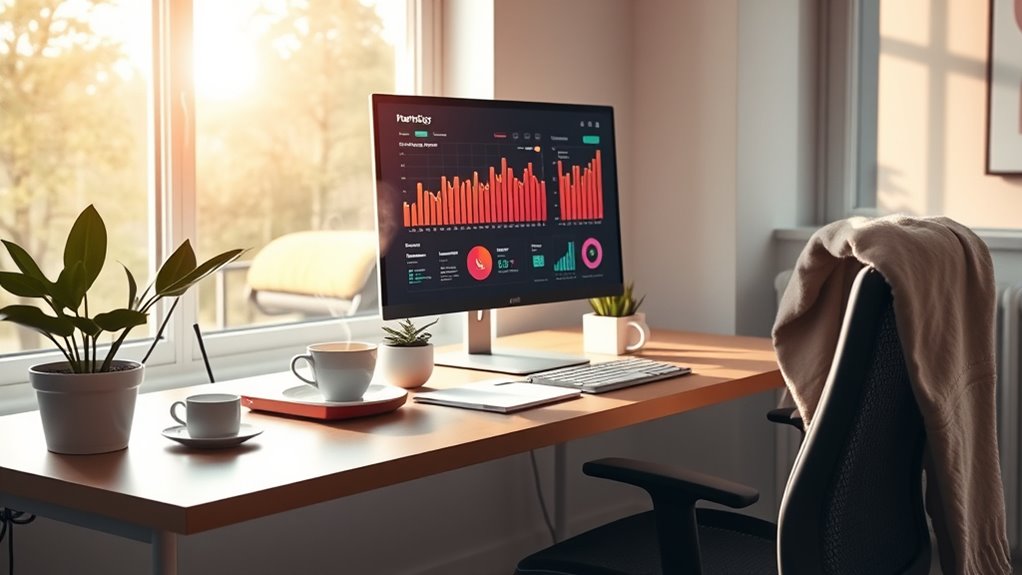To prevent burnout as a remote worker, set clear boundaries by defining your work hours and sticking to them. Develop a consistent daily routine with specific goals, and create a dedicated, distraction-free workspace. Remember to take regular breaks, incorporate physical activity, and stay mindful through stress-relief practices. Maintaining social connections also plays a essential role in your well-being. Keep these strategies in mind, and you’ll find more effective ways to stay balanced and energized.
Key Takeaways
- Establish clear work boundaries and set specific work hours to prevent overworking.
- Create a consistent daily routine with defined start and end times to enhance productivity.
- Designate a dedicated, ergonomic workspace to minimize distractions and promote focus.
- Prioritize regular breaks and incorporate physical activity to reduce stress and boost energy.
- Maintain social connections through virtual interactions and support networks to combat loneliness.
Establish Clear Work Boundaries

To prevent burnout while working remotely, establishing clear boundaries between your professional and personal life is vital. You need to prioritize effective time management, setting specific work hours and sticking to them. This helps prevent work from spilling into your personal space and keeps your workload balanced. By defining when your workday starts and ends, you reduce the risk of overworking and feeling overwhelmed. Communicate these boundaries to colleagues and family so they respect your work time. Remember, consistent boundaries support mental clarity and physical health, making it easier to stay productive without sacrificing your well-being. Clear work boundaries are essential for maintaining a healthy work-life balance and avoiding burnout in a remote setting. Incorporating structured routines can further enhance your ability to stick to these boundaries and promote overall well-being.
Create a Consistent Daily Routine

Having a consistent daily routine helps you stay focused and organized throughout your workday. When you establish regular start and end times, it improves your time management, making it easier to allocate periods for work, breaks, and personal activities. Setting clear goals each morning guides your priorities and keeps you motivated. By sticking to a routine, you avoid the temptation to procrastinate or overwork yourself, which can lead to burnout. Consistency also signals to your brain when it’s time to switch from work mode to relaxation, helping you maintain better work-life balance. Incorporating remote work productivity benefits into your routine can further enhance your efficiency and well-being. Remember to be flexible enough to adapt when needed, but overall, a steady routine keeps you productive and prevents overwhelm.
Designate a Dedicated Workspace

Setting up a dedicated workspace helps you establish clear boundaries between work and personal life. Make sure your area is ergonomically optimized to reduce strain and boost comfort. When your space is well-defined and comfortable, it’s easier to stay focused and prevent burnout. Additionally, organizing your workspace can help you identify signs of spoilage of your equipment or supplies, ensuring a healthier work environment.
Establish Boundaries Clearly
Establishing a dedicated workspace is essential for maintaining clear boundaries between work and personal life. When you designate a specific area, it becomes easier to manage your time effectively and protect your emotional resilience. To create this space, consider:
- Choosing a quiet, separate room or corner free from distractions
- Setting strict work hours to signal your availability
- Using visual cues like a sign or closed door to reinforce boundaries
- Keeping work materials confined to this area to prevent spillover
- Being mindful of the pinball machine weight when setting up your workspace to ensure safety and stability.
Optimize Ergonomic Setup
Creating an ergonomic setup within your dedicated workspace helps you work comfortably and reduces physical strain. Start by investing in an adjustable desk to easily modify your height and promote good posture. Use ergonomic accessories like an ergonomic chair, keyboard, and mouse to support your body during long hours. Proper positioning minimizes muscle tension and eye strain, preventing burnout. Consider this table to prioritize essential ergonomic features:
| Feature | Benefit | Recommendation |
|---|---|---|
| Adjustable Desk | Customizes height for comfort | Choose one that fits your workspace |
| Ergonomic Chair | Supports back and neck | Look for adjustable lumbar support |
| Keyboard & Mouse | Reduces wrist strain | Use ergonomic accessories |
| Monitor Position | Prevents eye strain | Keep screen at eye level |
| Footrest | Promotes circulation | Use if feet don’t touch the floor |
Additionally, integrating AI-powered ergonomic assessments can help optimize your workspace setup based on individual needs. A well-designed ergonomic setup boosts productivity and prevents burnout.
Prioritize Regular Breaks and Physical Activity

Taking regular breaks and staying physically active are essential steps to prevent burnout when working remotely. Incorporate these habits to boost your energy and focus:
- Schedule short breaks every hour to stand, stretch, and do stretching exercises that target your neck, shoulders, and back.
- Use these breaks to walk around your space or do quick cardio to increase circulation.
- Keep hydration habits in mind—drink water consistently to stay alert and avoid fatigue.
- During longer breaks, step outside for fresh air and sunlight, which helps reset your mind and body.
- Incorporating proper equipment such as ergonomic chairs or standing desks can further enhance your comfort and reduce physical strain.
Practice Mindfulness and Stress-Relief Techniques

Practicing mindfulness and stress-relief techniques can considerably reduce the mental strain of remote work. Start with mindfulness meditation to ground yourself and increase awareness of your thoughts and feelings. Even a few minutes daily can help you stay present and reduce anxiety. Incorporate stress relief exercises like deep breathing, progressive muscle relaxation, or visualization to quickly calm your mind during busy workdays. These practices can improve focus, decrease emotional exhaustion, and boost your overall well-being. Consistency is key—schedule dedicated moments for mindfulness and stress relief throughout your day. By making these techniques part of your routine, you’ll build resilience against burnout and create a healthier, more balanced remote work experience. Community engagement and sharing experiences can further enhance your mental health practices.
Maintain Social Connections and Support Systems

Maintaining social connections and support systems is essential for preventing burnout in remote work settings, especially since isolation can quickly lead to emotional exhaustion. To stay connected, consider these strategies:
- Schedule regular virtual team building activities to foster camaraderie and collaboration.
- Join online support groups related to your industry or personal interests for shared encouragement.
- Make time for informal chats with colleagues to maintain personal bonds.
- Use video calls instead of emails to enhance communication quality and emotional connection.
- Prioritize social engagement by integrating regular interactions into your routine to reinforce your support network.
These approaches help reduce feelings of loneliness, boost morale, and create a sense of belonging. By actively engaging in virtual team building and online support groups, you strengthen your support network, which plays a critical role in maintaining mental well-being and preventing burnout.
Frequently Asked Questions
How Can Remote Workers Recognize Early Signs of Burnout?
You can recognize early signs of burnout by paying attention to recognition cues and stress indicators. Notice if you’re feeling increasingly exhausted, irritable, or overwhelmed, and if your motivation drops. Watch for physical symptoms like headaches or trouble sleeping. If you start neglecting self-care or withdrawing from work tasks, these are key stress indicators. Staying mindful of these cues helps you address issues early before burnout worsens.
What Tools Best Support Boundary-Setting for Remote Employees?
Ever wonder how you can protect your personal space while working remotely? Digital boundaries tools like website blockers, focus apps, and calendar management software help you set clear limits. They enable you to prioritize tasks and manage your time effectively. By establishing firm boundaries and sticking to designated work hours, you prevent burnout and maintain work-life balance. Isn’t it time you used these tools to create a healthier, more productive remote work environment?
How Does Company Culture Influence Remote Burnout Prevention?
Your company’s culture profoundly impacts remote burnout prevention by shaping company values and leadership influence. When leadership actively promotes work-life balance and open communication, it fosters a supportive environment that reduces stress. A culture that prioritizes employee well-being encourages you to set boundaries and take breaks without fear of judgment. Ultimately, a positive company culture aligns values with leadership actions, helping you stay engaged and prevent burnout while working remotely.
Are There Specific Industries More Prone to Remote Burnout?
Think of certain industries as fragile glassware, more prone to shattering under pressure. Industries like healthcare, tech, and finance face industry-specific challenges, such as high stress and tight deadlines, which heighten remote burnout risks. Remote work demographics also play a role—those juggling family or lacking boundaries are more vulnerable. Recognizing these factors helps you tailor strategies to protect your well-being and maintain resilience in demanding sectors.
How Can Managers Effectively Support Remote Team Well-Being?
As a manager, you can support your remote team’s well-being by prioritizing open employee communication and actively listening to their needs. Implement mental health initiatives like flexible work hours and access to counseling resources. Regular check-ins help you gauge workload and stress levels, showing your team you care. By fostering a supportive environment, you boost morale, reduce burnout risks, and promote a healthier, more engaged remote workforce.
Conclusion
By implementing these burnout prevention strategies, you’ll create a healthier work-life balance and boost your well-being. Did you know that remote workers who set clear boundaries experience 25% less stress? Staying proactive with routines, breaks, and social connections can make a significant difference. Remember, taking small steps today can prevent burnout tomorrow—so prioritize self-care and stay connected to keep your remote work experience sustainable and fulfilling.









